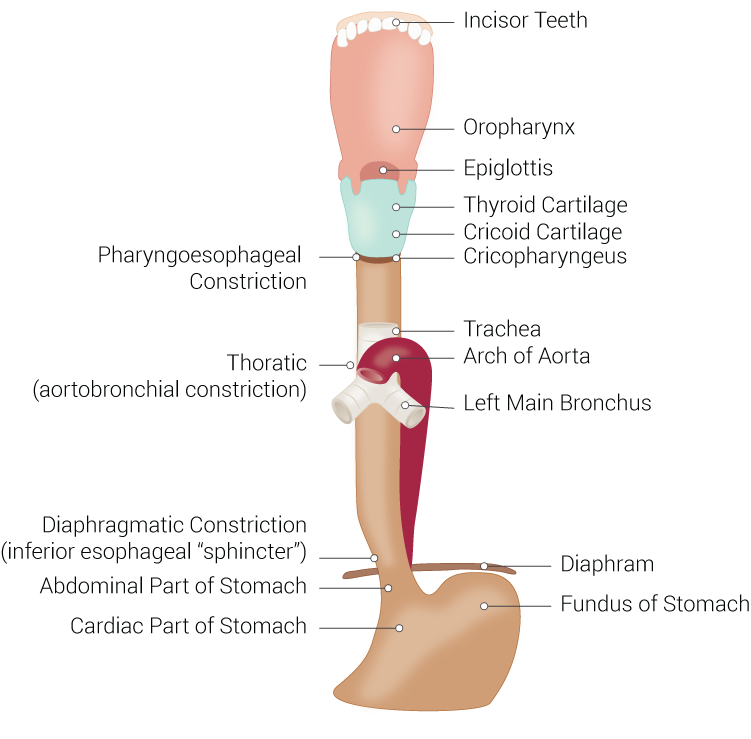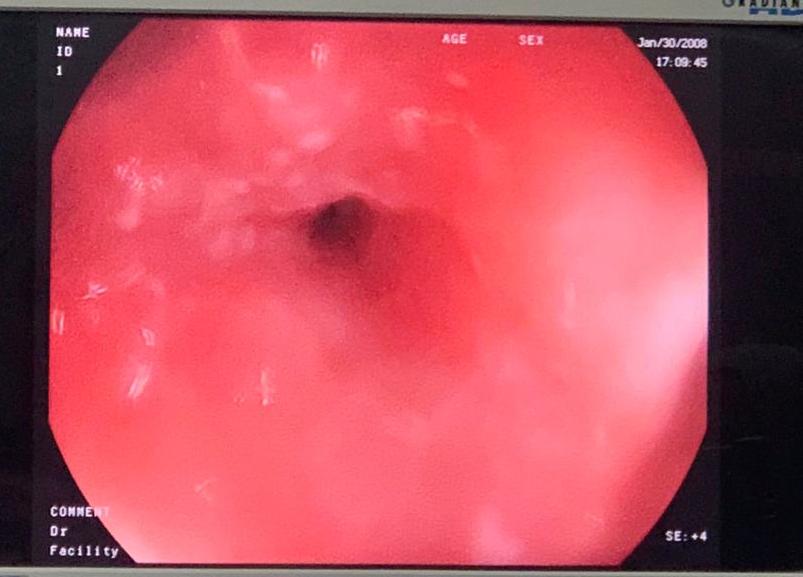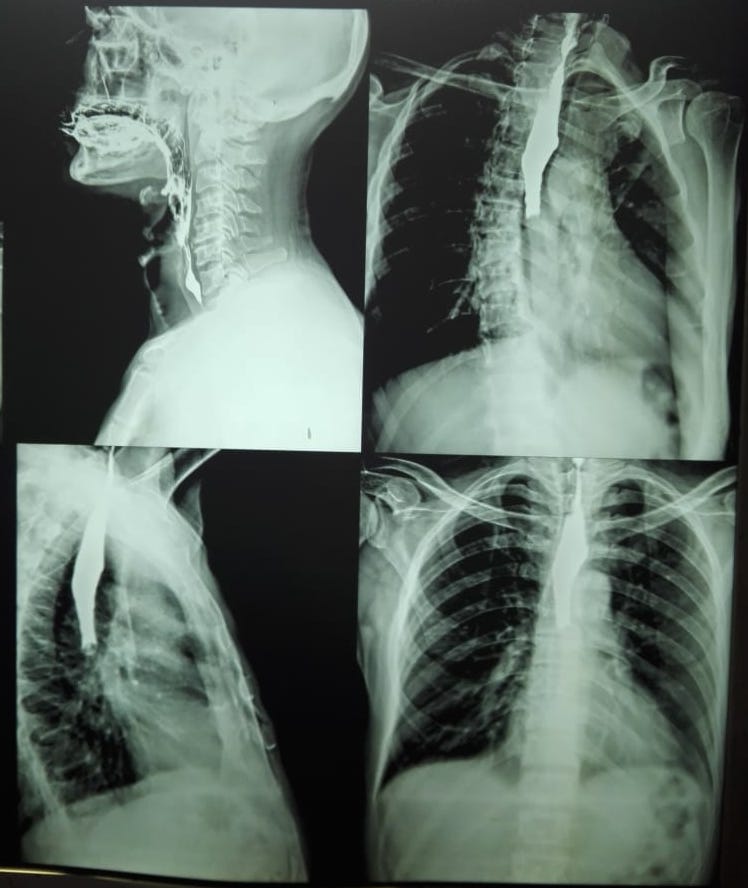[1]
Hall AH, Jacquemin D, Henny D, Mathieu L, Josset P, Meyer B. Corrosive substances ingestion: a review. Critical reviews in toxicology. 2019 Sep:49(8):637-669. doi: 10.1080/10408444.2019.1707773. Epub
[PubMed PMID: 32009535]
[2]
Li Y, Langworthy J, Xu L, Cai H, Yang Y, Lu Y, Wallach SL, Friedenberg FK. Nationwide estimate of emergency department visits in the United States related to caustic ingestion. Diseases of the esophagus : official journal of the International Society for Diseases of the Esophagus. 2020 Jun 15:33(6):. pii: doaa012. doi: 10.1093/dote/doaa012. Epub
[PubMed PMID: 32129451]
[3]
Mamede RC, de Mello Filho FV. Ingestion of caustic substances and its complications. Sao Paulo medical journal = Revista paulista de medicina. 2001 Jan 4:119(1):10-5
[PubMed PMID: 11175619]
[4]
Kalayarasan R, Ananthakrishnan N, Kate V. Corrosive Ingestion. Indian journal of critical care medicine : peer-reviewed, official publication of Indian Society of Critical Care Medicine. 2019 Dec:23(Suppl 4):S282-S286. doi: 10.5005/jp-journals-10071-23305. Epub
[PubMed PMID: 32021005]
[5]
Poley JW, Steyerberg EW, Kuipers EJ, Dees J, Hartmans R, Tilanus HW, Siersema PD. Ingestion of acid and alkaline agents: outcome and prognostic value of early upper endoscopy. Gastrointestinal endoscopy. 2004 Sep:60(3):372-7
[PubMed PMID: 15332026]
[6]
Hoffman RS, Howland MA, Kamerow HN, Goldfrank LR. Comparison of titratable acid/alkaline reserve and pH in potentially caustic household products. Journal of toxicology. Clinical toxicology. 1989:27(4-5):241-6
[PubMed PMID: 2600988]
[7]
Chen RJ, O'Malley RN, Salzman M. Updates on the Evaluation and Management of Caustic Exposures. Emergency medicine clinics of North America. 2022 May:40(2):343-364. doi: 10.1016/j.emc.2022.01.013. Epub 2022 Apr 5
[PubMed PMID: 35461627]
[8]
Hoffman RS, Burns MM, Gosselin S. Ingestion of Caustic Substances. The New England journal of medicine. 2020 Apr 30:382(18):1739-1748. doi: 10.1056/NEJMra1810769. Epub
[PubMed PMID: 32348645]
[9]
Contini S, Scarpignato C. Caustic injury of the upper gastrointestinal tract: a comprehensive review. World journal of gastroenterology. 2013 Jul 7:19(25):3918-30. doi: 10.3748/wjg.v19.i25.3918. Epub
[PubMed PMID: 23840136]
[10]
Katzka DA. Caustic Injury to the Esophagus. Current treatment options in gastroenterology. 2001 Feb:4(1):59-66
[PubMed PMID: 11177682]
[11]
Previtera C, Giusti F, Guglielmi M. Predictive value of visible lesions (cheeks, lips, oropharynx) in suspected caustic ingestion: may endoscopy reasonably be omitted in completely negative pediatric patients? Pediatric emergency care. 1990 Sep:6(3):176-8
[PubMed PMID: 2216918]
[12]
Gupta SK, Croffie JM, Fitzgerald JF. Is esophagogastroduodenoscopy necessary in all caustic ingestions? Journal of pediatric gastroenterology and nutrition. 2001 Jan:32(1):50-3
[PubMed PMID: 11176325]
[13]
Celik B, Nadir A, Sahin E, Kaptanoglu M. Is esophagoscopy necessary for corrosive ingestion in adults? Diseases of the esophagus : official journal of the International Society for Diseases of the Esophagus. 2009:22(8):638-41. doi: 10.1111/j.1442-2050.2009.00987.x. Epub 2009 Jun 9
[PubMed PMID: 19515187]
[14]
Bosnali O, Moralioglu S, Celayir A, Pektas OZ. Is rigid endoscopy necessary with childhood corrosive ingestion? a retrospective comparative analysis of 458 cases. Diseases of the esophagus : official journal of the International Society for Diseases of the Esophagus. 2017 Feb 1:30(3):1-7. doi: 10.1111/dote.12458. Epub
[PubMed PMID: 26822961]
Level 2 (mid-level) evidence
[15]
Millar AJ, Cox SG. Caustic injury of the oesophagus. Pediatric surgery international. 2015 Feb:31(2):111-21. doi: 10.1007/s00383-014-3642-3. Epub 2014 Nov 29
[PubMed PMID: 25432099]
[16]
Methasate A, Lohsiriwat V. Role of endoscopy in caustic injury of the esophagus. World journal of gastrointestinal endoscopy. 2018 Oct 16:10(10):274-282. doi: 10.4253/wjge.v10.i10.274. Epub
[PubMed PMID: 30364838]
[17]
Gschossmann JM, Schroeder R, Wyler F, Scheurer U, Schiemann U. [Whether or not to perform an early endoscopy following ingestion of potentially caustic agents - a retrospective longterm analysis in a tertiary referral institution]. Zeitschrift fur Gastroenterologie. 2016 Jun:54(6):548-55. doi: 10.1055/s-0042-106730. Epub 2016 Jun 10
[PubMed PMID: 27284929]
Level 2 (mid-level) evidence
[18]
Di Nardo G, Betalli P, Illiceto MT, Giulia G, Martemucci L, Caruso F, Lisi G, Romano G, Villa MP, Ziparo C, Pensabene L, Vassallo F, Quitadamo P. Caustic Ingestion in Children: 1 Year Experience in 3 Italian Referral Centers. Journal of pediatric gastroenterology and nutrition. 2020 Jul:71(1):19-22. doi: 10.1097/MPG.0000000000002685. Epub
[PubMed PMID: 32142003]
[19]
Acehan S, Satar S, Gulen M, Avci A. Evaluation of corrosive poisoning in adult patients. The American journal of emergency medicine. 2021 Jan:39():65-70. doi: 10.1016/j.ajem.2020.01.016. Epub 2020 Jan 8
[PubMed PMID: 31982223]
[20]
Temiz A, Oguzkurt P, Ezer SS, Ince E, Hicsonmez A. Predictability of outcome of caustic ingestion by esophagogastroduodenoscopy in children. World journal of gastroenterology. 2012 Mar 14:18(10):1098-103. doi: 10.3748/wjg.v18.i10.1098. Epub
[PubMed PMID: 22416185]
[21]
Kamijo Y, Kondo I, Kokuto M, Kataoka Y, Soma K. Miniprobe ultrasonography for determining prognosis in corrosive esophagitis. The American journal of gastroenterology. 2004 May:99(5):851-4
[PubMed PMID: 15128349]
[22]
Chiu HM, Lin JT, Huang SP, Chen CH, Yang CS, Wang HP. Prediction of bleeding and stricture formation after corrosive ingestion by EUS concurrent with upper endoscopy. Gastrointestinal endoscopy. 2004 Nov:60(5):827-33
[PubMed PMID: 15557970]
[23]
Chirica M, Resche-Rigon M, Pariente B, Fieux F, Sabatier F, Loiseaux F, Munoz-Bongrand N, Gornet JM, Brette MD, Sarfati E, Azoulay E, Zagdanski AM, Cattan P. Computed tomography evaluation of high-grade esophageal necrosis after corrosive ingestion to avoid unnecessary esophagectomy. Surgical endoscopy. 2015 Jun:29(6):1452-61. doi: 10.1007/s00464-014-3823-0. Epub 2014 Aug 27
[PubMed PMID: 25159655]
[24]
Bruzzi M, Chirica M, Resche-Rigon M, Corte H, Voron T, Sarfati E, Zagdanski AM, Cattan P. Emergency Computed Tomography Predicts Caustic Esophageal Stricture Formation. Annals of surgery. 2019 Jul:270(1):109-114. doi: 10.1097/SLA.0000000000002732. Epub
[PubMed PMID: 29533267]
[25]
Lurie Y, Slotky M, Fischer D, Shreter R, Bentur Y. The role of chest and abdominal computed tomography in assessing the severity of acute corrosive ingestion. Clinical toxicology (Philadelphia, Pa.). 2013 Nov:51(9):834-7. doi: 10.3109/15563650.2013.837171. Epub 2013 Sep 13
[PubMed PMID: 24032468]
[26]
Bentur Y, Slotky M, Fischer D, Shreter R, Lurie Y. The role of chest and abdominal computed tomography in assessing the severity of acute corrosive ingestion. Clinical toxicology (Philadelphia, Pa.). 2014 Jan:52(1):83. doi: 10.3109/15563650.2013.869339. Epub 2013 Dec 19
[PubMed PMID: 24350559]
[27]
Bahrami-Motlagh H, Hadizadeh-Neisanghalb M, Peyvandi H. Diagnostic Accuracy of Computed Tomography Scan in Detection of Upper Gastrointestinal Tract Injuries Following Caustic Ingestion. Emergency (Tehran, Iran). 2017:5(1):e61
[PubMed PMID: 28894776]
[28]
Homan CS, Maitra SR, Lane BP, Thode HC Jr, Davidson L. Histopathologic evaluation of the therapeutic efficacy of water and milk dilution for esophageal acid injury. Academic emergency medicine : official journal of the Society for Academic Emergency Medicine. 1995 Jul:2(7):587-91
[PubMed PMID: 8521203]
[29]
Homan CS, Maitra SR, Lane BP, Thode HC, Sable M. Therapeutic effects of water and milk for acute alkali injury of the esophagus. Annals of emergency medicine. 1994 Jul:24(1):14-20
[PubMed PMID: 8010543]
[30]
Chobanian SJ. Accidental ingestion of liquid zinc chloride: local and systemic effects. Annals of emergency medicine. 1981 Feb:10(2):91-3
[PubMed PMID: 6784611]
[31]
Singer AJ, Mofenson HC, Caraccio TR, Ilasi J. Mercuric chloride poisoning due to ingestion of a stool fixative. Journal of toxicology. Clinical toxicology. 1994:32(5):577-82
[PubMed PMID: 7932917]
[32]
Yoshida M, Satoh H, Igarashi M, Akashi K, Yamamura Y, Yoshida K. Acute mercury poisoning by intentional ingestion of mercuric chloride. The Tohoku journal of experimental medicine. 1997 Aug:182(4):347-52
[PubMed PMID: 9352627]
[33]
Cakal B, Akbal E, Köklü S, Babalı A, Koçak E, Taş A. Acute therapy with intravenous omeprazole on caustic esophageal injury: a prospective case series. Diseases of the esophagus : official journal of the International Society for Diseases of the Esophagus. 2013 Jan:26(1):22-6. doi: 10.1111/j.1442-2050.2011.01319.x. Epub 2012 Feb 14
[PubMed PMID: 22332893]
Level 2 (mid-level) evidence
[34]
Hawkins DB, Demeter MJ, Barnett TE. Caustic ingestion: controversies in management. A review of 214 cases. The Laryngoscope. 1980 Jan:90(1):98-109
[PubMed PMID: 7356772]
Level 3 (low-level) evidence
[35]
Mamede RC, De Mello Filho FV. Treatment of caustic ingestion: an analysis of 239 cases. Diseases of the esophagus : official journal of the International Society for Diseases of the Esophagus. 2002:15(3):210-3
[PubMed PMID: 12444992]
Level 3 (low-level) evidence
[36]
Kochhar R, Poornachandra KS, Puri P, Dutta U, Sinha SK, Sethy PK, Wig JD, Nagi B, Singh K. Comparative evaluation of nasoenteral feeding and jejunostomy feeding in acute corrosive injury: a retrospective analysis. Gastrointestinal endoscopy. 2009 Nov:70(5):874-80. doi: 10.1016/j.gie.2009.03.009. Epub 2009 Jul 1
[PubMed PMID: 19573868]
Level 2 (mid-level) evidence
[37]
Shikowitz MJ, Levy J, Villano D, Graver LM, Pochaczevsky R. Speech and swallowing rehabilitation following devastating caustic ingestion: techniques and indicators for success. The Laryngoscope. 1996 Feb:106(2 Pt 2 Suppl 78):1-12
[PubMed PMID: 8569409]
[38]
Jain AL, Robertson GJ, Rudis MI. Surgical issues in the poisoned patient. Emergency medicine clinics of North America. 2003 Nov:21(4):1117-44
[PubMed PMID: 14708821]
[39]
Anderson KD, Rouse TM, Randolph JG. A controlled trial of corticosteroids in children with corrosive injury of the esophagus. The New England journal of medicine. 1990 Sep 6:323(10):637-40
[PubMed PMID: 2200966]
[40]
Fulton JA, Hoffman RS. Steroids in second degree caustic burns of the esophagus: a systematic pooled analysis of fifty years of human data: 1956-2006. Clinical toxicology (Philadelphia, Pa.). 2007 May:45(4):402-8
[PubMed PMID: 17486482]
Level 1 (high-level) evidence
[41]
Pelclová D, Navrátil T. Do corticosteroids prevent oesophageal stricture after corrosive ingestion? Toxicological reviews. 2005:24(2):125-9
[PubMed PMID: 16180932]
[42]
Usta M, Erkan T, Cokugras FC, Urganci N, Onal Z, Gulcan M, Kutlu T. High doses of methylprednisolone in the management of caustic esophageal burns. Pediatrics. 2014 Jun:133(6):E1518-24
[PubMed PMID: 24864182]
[43]
Boukthir S, Fetni I, Mrad SM, Mongalgi MA, Debbabi A, Barsaoui S. [High doses of steroids in the management of caustic esophageal burns in children]. Archives de pediatrie : organe officiel de la Societe francaise de pediatrie. 2004 Jan:11(1):13-7
[PubMed PMID: 14700754]
[44]
Tiryaki T, Livanelioğlu Z, Atayurt H. Early bougienage for relief of stricture formation following caustic esophageal burns. Pediatric surgery international. 2005 Feb:21(2):78-80
[PubMed PMID: 15619090]
[45]
Berkovits RN, Bos CE, Wijburg FA, Holzki J. Caustic injury of the oesophagus. Sixteen years experience, and introduction of a new model oesophageal stent. The Journal of laryngology and otology. 1996 Nov:110(11):1041-5
[PubMed PMID: 8944879]
[46]
Zhou JH, Jiang YG, Wang RW, Lin YD, Gong TQ, Zhao YP, Ma Z, Tan QY. Management of corrosive esophageal burns in 149 cases. The Journal of thoracic and cardiovascular surgery. 2005 Aug:130(2):449-55
[PubMed PMID: 16077412]
Level 3 (low-level) evidence
[47]
Wang RW, Zhou JH, Jiang YG, Fan SZ, Gong TQ, Zhao YP, Tan QY, Lin YD. Prevention of stricture with intraluminal stenting through laparotomy after corrosive esophageal burns. European journal of cardio-thoracic surgery : official journal of the European Association for Cardio-thoracic Surgery. 2006 Aug:30(2):207-11
[PubMed PMID: 16829082]
[48]
Günel E, Cağlayan F, Cağlayan O, Canbilen A, Tosun M. Effect of antioxidant therapy on collagen synthesis in corrosive esophageal burns. Pediatric surgery international. 2002 Jan:18(1):24-7
[PubMed PMID: 11793058]
[49]
Yukselen V, Karaoglu AO, Ozutemiz O, Yenisey C, Tuncyurek M. Ketotifen ameliorates development of fibrosis in alkali burns of the esophagus. Pediatric surgery international. 2004 Jun:20(6):429-33
[PubMed PMID: 15108014]
[50]
Demirbilek S, Aydin G, Yücesan S, Vural H, Bitiren M. Polyunsaturated phosphatidylcholine lowers collagen deposition in a rat model of corrosive esophageal burn. European journal of pediatric surgery : official journal of Austrian Association of Pediatric Surgery ... [et al] = Zeitschrift fur Kinderchirurgie. 2002 Feb:12(1):8-12
[PubMed PMID: 11967752]
[51]
Ozçelik MF, Pekmezci S, Saribeyoğlu K, Unal E, Gümüştaş K, Doğusoy G. The effect of halofuginone, a specific inhibitor of collagen type 1 synthesis, in the prevention of esophageal strictures related to caustic injury. American journal of surgery. 2004 Feb:187(2):257-60
[PubMed PMID: 14769315]
[52]
Duman L, Büyükyavuz BI, Altuntas I, Gökcimen A, Ceyhan L, Darici H, Aylak F, Tomruk O. The efficacy of single-dose 5-fluorouracil therapy in experimental caustic esophageal burn. Journal of pediatric surgery. 2011 Oct:46(10):1893-7. doi: 10.1016/j.jpedsurg.2011.03.001. Epub
[PubMed PMID: 22008323]
[53]
Kaygusuz I, Celik O, Ozkaya O O, Yalçin S, Keleş E, Cetinkaya T. Effects of interferon-alpha-2b and octreotide on healing of esophageal corrosive burns. The Laryngoscope. 2001 Nov:111(11 Pt 1):1999-2004
[PubMed PMID: 11801986]
[54]
Javed A, Pal S, Krishnan EK, Sahni P, Chattopadhyay TK. Surgical management and outcomes of severe gastrointestinal injuries due to corrosive ingestion. World journal of gastrointestinal surgery. 2012 May 27:4(5):121-5. doi: 10.4240/wjgs.v4.i5.121. Epub
[PubMed PMID: 22655126]
[55]
Ryu HH, Jeung KW, Lee BK, Uhm JH, Park YH, Shin MH, Kim HL, Heo T, Min YI. Caustic injury: can CT grading system enable prediction of esophageal stricture? Clinical toxicology (Philadelphia, Pa.). 2010 Feb:48(2):137-42. doi: 10.3109/15563650903585929. Epub
[PubMed PMID: 20199130]
[57]
Mensier A, Onimus T, Ernst O, Leroy C, Zerbib P. Evaluation of severe caustic gastritis by computed tomography and its impact on management. Journal of visceral surgery. 2020 Dec:157(6):469-474. doi: 10.1016/j.jviscsurg.2020.02.001. Epub 2020 Feb 20
[PubMed PMID: 32088182]
[58]
Faron M, Corte H, Poghosyan T, Bruzzi M, Voron T, Sarfati E, Cattan P, Chirica M. Quality of Life After Caustic Ingestion. Annals of surgery. 2021 Dec 1:274(6):e529-e534. doi: 10.1097/SLA.0000000000003774. Epub
[PubMed PMID: 31972647]
Level 2 (mid-level) evidence
[59]
O'Grady M, Firth R, Roberts R. Intensive care unit utilisation post-oesophagectomy. The New Zealand medical journal. 2020 Feb 21:133(1510):56-61
[PubMed PMID: 32078601]
[60]
Findlay M, Purvis M, Venman R, Luong R, Carey S. Nutritional management of patients with oesophageal cancer throughout the treatment trajectory: benchmarking against best practice. Supportive care in cancer : official journal of the Multinational Association of Supportive Care in Cancer. 2020 Dec:28(12):5963-5971. doi: 10.1007/s00520-020-05416-x. Epub 2020 Apr 13
[PubMed PMID: 32281035]
[61]
Povilavičius J, Samalavičius NE, Verkauskas G, Trainavičius K, Povilavičienė M. Conservative treatment of caustic oesophageal injuries in children: 15 years of experience in a tertiary care paediatric centre. Przeglad gastroenterologiczny. 2019:14(4):286-291. doi: 10.5114/pg.2019.90255. Epub 2019 Dec 20
[PubMed PMID: 31988676]
[62]
Sharp CA, Swaithes L, Ellis B, Dziedzic K, Walsh N. Implementation research: making better use of evidence to improve healthcare. Rheumatology (Oxford, England). 2020 Aug 1:59(8):1799-1801. doi: 10.1093/rheumatology/keaa088. Epub
[PubMed PMID: 32252071]
[63]
Labrague LJ, De Los Santos JAA, Falguera CC, Nwafor CE, Galabay JR, Rosales RA, Firmo CN. Predictors of nurses' turnover intention at one and five years' time. International nursing review. 2020 Jun:67(2):191-198. doi: 10.1111/inr.12581. Epub 2020 Mar 23
[PubMed PMID: 32202329]
[64]
Roy A, Druker S, Hoge EA, Brewer JA. Physician Anxiety and Burnout: Symptom Correlates and a Prospective Pilot Study of App-Delivered Mindfulness Training. JMIR mHealth and uHealth. 2020 Apr 1:8(4):e15608. doi: 10.2196/15608. Epub 2020 Apr 1
[PubMed PMID: 32234708]
Level 3 (low-level) evidence
[65]
Moore KA, O'Brien BC, Thomas LR. "I Wish They Had Asked": a Qualitative Study of Emotional Distress and Peer Support During Internship. Journal of general internal medicine. 2020 Dec:35(12):3443-3448. doi: 10.1007/s11606-020-05803-4. Epub 2020 Mar 30
[PubMed PMID: 32232665]
Level 2 (mid-level) evidence



